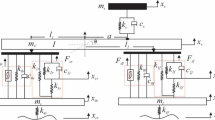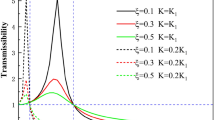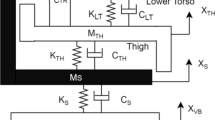Abstract
Introduction
Vibration suspension system is used in the automobiles to mitigate the excitations that can come from the travel over various road profiles. The conventionally used suspension systems are linear devices that are effective against high frequencies; however, they have limitations in isolation ability in the low-frequency ranges. Hence, nonlinear isolation system can be used to overcome such limitations.
Methodology
The quasi-zero stiffness (QZS) characteristics are efficient in the vibration isolation and can provide isolation efficiently against low-frequency excitations as well. This concept is taken into consideration and has designed a nonlinear vibration isolation system with QZS behaviour. The negative stiffness is achieved through the inclined spring arrangement, and the positive stiffness is obtained from the pneumatic system. The force–displacement model is used to develop the approximate dynamic modelling for small displacement.
Results
The performance is studied against various road profiles as per ISO 8608. The results showed that the isolation system effectively isolates the external excitations from the road profile and shows a high isolation capability in the higher velocities. The study shows the proposed system reduced on an average of 92% and 88% of external excitations in road class B–D and E–H, respectively.
Conclusions
Based on the computational study conducted in this work on the developed design, the isolation system is found to be effective in vibration isolation. The QZS system parameters highly influence the performance of the isolation system. The system developed in this work can be used to test for real-time automobile applications.









Similar content being viewed by others
References
Ibrahim RA (2008) Recent advances in nonlinear passive vibration isolators. J Sound Vib 314(3):371–452
Lu Z et al (2018) Nonlinear dissipative devices in structural vibration control: a review. J Sound Vib 423:18–49
Balaji PS et al (2016) Static lateral stiffness of wire rope isolators. Mech Based Des Struct Mach 44(4):462–475
Balaji PS, SelvaKumar KK (2020) Applications of nonlinearity in passive vibration control: a review. J Vib Eng Technol. https://doi.org/10.1007/s42417-020-00216-3
Eluri KV et al (2019) Analysis of whole body vibration of a two-wheeler rider. SAE International, Warrendale
Sun X, Jing X (2015) Multi-direction vibration isolation with quasi-zero stiffness by employing geometrical nonlinearity. MechSyst Signal Process 62:149–163
Alabuzhev PM, Rivin EI (1989) Vibration protection and measuring systems with quasi-zero stiffness. Taylor & Francis, New York
Xingtian L, Xiuchang H, Hongxing H (2013) Performance of a zero stiffness isolator under shock excitations. J Vib Control 20(14):2090–2099
Li FS, Chen Q, Zhou JH (2018) Dynamic properties of a novel vibration isolator with negative stiffness. J VibEngTechnol 6(3):239–247
Yang X et al (2020) Structural design and isolation characteristic analysis of new quasi-zero-stiffness. J VibEngTechnol 8(1):47–58
Carrella A et al (2009) On the force transmissibility of a vibration isolator with quasi-zero-stiffness. J Sound Vib 322(4):707–717
Carrella A, Brennan MJ, Waters TP (2007) Static analysis of a passive vibration isolator with quasi-zero-stiffness characteristic. J Sound Vib 301(3):678–689
Huang X et al (2014) Vibration isolation characteristics of a nonlinear isolator using Euler buckled beam as negative stiffness corrector: a theoretical and experimental study. J Sound Vib 333(4):1132–1148
Araki Y et al (2015) Integrated mechanical and material design of quasi-zero-stiffness vibration isolator with superelastic Cu–Al–Mn shape memory alloy bars. J Sound Vib 358:74–83
Zhou N, Liu K (2010) A tunable high-static–low-dynamic stiffness vibration isolator. J Sound Vib 329(9):1254–1273
Zhu T et al (2015) Vibration isolation using six degree-of-freedom quasi-zero stiffness magnetic levitation. J Sound Vib 358:48–73
Sun X et al (2014) Vibration isolation via a scissor-like structured platform. J Sound Vib 333(9):2404–2420
Ishida S, Suzuki K, Shimosaka H (2017) Design and experimental analysis of origami-inspired vibration isolator with quasi-zero-stiffness characteristic. J VibAcoust 139(5):051004
Wang X et al (2020) Vibration suppression for post-capture spacecraft via a novel bio-inspired Stewart isolation system. Acta Astronaut 168:1–22
Feng X et al (2019) Bio-inspired anti-vibration with nonlinear inertia coupling. MechSyst Signal Process 124:562–595
Kim GW, Kang J (2019) The V-shaped band-stop vibration isolator inspired by middle ear. ApplAcoust 150:162–168
Cai C et al (2020) Design and numerical validation of quasi-zero-stiffness metamaterials for very low-frequency band gaps. Compos Struct 236:111862
Fan H et al (2020) Design of metastructures with quasi-zero dynamic stiffness for vibration isolation. Compos Struct. https://doi.org/10.1016/j.compstruct.2020.112244
Múčka P (2018) Simulated road profiles according to ISO 8608 in vibration analysis. J Test Eval 46(1):405–418
Acknowledgements
The author would like to thank the Department of Mechanical Engineering, National Institute of Technology Rourkela for extending the facilities for this work.
Funding
This research did not receive any specific grant from funding agencies in the public, commercial, or not-for-profit sectors.
Author information
Authors and Affiliations
Corresponding author
Ethics declarations
Conflict of interest
The author declares that they have no known competing financial interests or personal relationships that could have appeared to influence the work reported in this paper.
Additional information
Publisher's Note
Springer Nature remains neutral with regard to jurisdictional claims in published maps and institutional affiliations.
Rights and permissions
About this article
Cite this article
Suman, S., Balaji, P.S., Selvakumar, K. et al. Nonlinear Vibration Control Device for a Vehicle Suspension Using Negative Stiffness Mechanism. J. Vib. Eng. Technol. 9, 957–966 (2021). https://doi.org/10.1007/s42417-020-00275-6
Received:
Revised:
Accepted:
Published:
Issue Date:
DOI: https://doi.org/10.1007/s42417-020-00275-6




